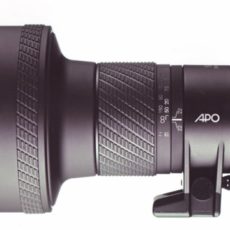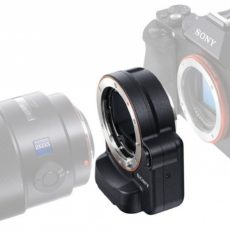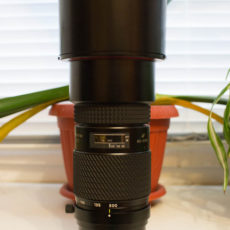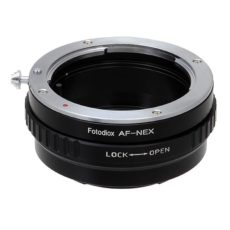Tokina 80-200mm f/2.8 AT-X PRO AF
This camera glass has a great build quality and is made with high-quality materials. It has a smooth autofocus system and can also be used in manual focus mode. The lens elements are coated to reduce glare and improve image quality. It has a beautiful bokeh, which means that the out-of-focus areas in your photos will look smooth and creamy. The resolution is very high, which means that your photos will be sharp and detailed. This photographic lens is a great alternative to other similar lenses on the market. It has a fast aperture, which means that you can use it in low light situations without having to use a flash. It is a great choice for photographers who need a high-quality telephoto lens. The manufacturing time of this lens is relatively fast, which means that you won’t have to wait long to get your hands on it. Overall, the Tokina 80-200mm f/2.8 AT-X PRO AF lens is a great choice for photographers who need a high-quality telephoto lens.
Sure! Here’s my revised review of the Tokina 80-200mm f/2.8 AT-X PRO AF camera lens:
Nikkor 80-200mm f 2.8 ED, the workhorse
Positives:
This lens is a true workhorse, with exceptional build quality and a smooth, professional look. The AF is spot on and its performance is impeccable. Whether it’s sports, wildlife or portraits, this lens is a definite leader in the Nikkor lineup, with great depth of field and overall quality of results.
Negatives:
One downside is that the lens is quite heavy, which some photographers may find cumbersome to carry around. Additionally, the lens is not the fastest for wildlife photography, requiring skill and patience in capturing those quick shots.
Conclusion:
Overall, the Nikkor 80-200mm f 2.8 ED is an excellent lens that will outlast the cameras it is mounted on. While it may not be the best fit for all styles of photography, it excels in sports, wildlife and portrait work. For serious photographers who value solid build quality and impressive performance, the Nikkor 80-200mm f 2.8 ED is a worthwhile investment.
Optical design
Has 9 aperture blades, with this amount of aperture blades you will be satisfied with the result. With high brightness value, it has the ability to collect light even in poor lighting conditions
Physical characteristics
184 mm long, with this size carry only if you use it. Weights 1350 grams so it is a heavy lens, consider using its own lens bag. With a lens filter diameter of 77 mm this lens deserves a good quality filter, this is commonly filter size, provides a range of filter options.





dyxum.com –
26 dyxum.com user rated as 4.52/5
ebay.com –
31 ebay.com user rated as 4.75/5
Ebay.com Nov 02, 2008 –
You may not need it, but you definitely want it! This is a superb lens. It is sharp wide open (f/2.8) and even better stopped down (i.e. 4-5.6). I’m using this lens on a Nikon D80 and D40 (meters but does not autofocus). If you are serious about using this lens on the D40 you should have a split focusing ring installed.
My kids play sports (soccer and football). This lens works great under stadium lights (usually ISO 800-1600, f/2.8, 1/200th) without a flash. Make sure you use the proper white balance (Auto works most of the time). During concerts this lens works great.
The only drawbacks of this lens are found at the 80mm focal length. On the DX sensor the crop factor means you are using a 120mm lens. You might find this a bit restrictive since the view is very narrow. Again, this is not a problem for outdoor sports, but might pose a problem in a small venue (i.e. sidelines of a basketball court).
I wondered if the zoom would be fast enough for Highschool football. It is just fine. In many instances I will manually focus, but generally autofocus works great. If you are used to AFS lenses, this could take some getting used to. You have to physically overide the autofocus using the selector switch between the zoom and focus rings. I never use the focus limiter.
Ebay.com Feb 09, 2010 –
Nikon AF 80-200mm f/2.8D Lens Name: Nikon calls this the Nikon ED AF Nikkor 80-200mm f/2.8 D
Optics: Sixteen elements in eleven groups. Three of them are of ED glass.
Diaphragm: 9-bladed diaphragm with nine conventional straight blades. They make a nice 9-sided polygon at all apertures, unlike the AF-S that simulates a circle at larger apertures.
Filters: Uses standard 77mm filters.
Close Focus: About 5.5 feet, which is pretty good. That’s about a foot less close than the AF-S when I compared the two directly, and about the same as the 180/2.8AF.
Size: 3.4″ (87mm) around by 7.4″ (187mm) long.
Weight: 2 pounds, 14 oz (46 ounces total or 1,300g)
Case: It comes with a fairly useless case. Just put it away someplace for when you sell the lens.
Nikon Product Number: 1986, in catalog as of spring 2008.
Performance
This is an extremely sharp lens. I have only shot with it a couple of times.
Distortion performance is also good for a zoom:
80-115mm: fairly neutral
200mm: some pincushion distortion
It has the usual light falloff. Here’s a page, made at 200mm by someone else illustrating the falloff.
Autofocus is accurate. In real photographs the focus is always dead on at f/2.8. This is important to me, some other lenses’ focus errors exclude me from being able to get good results wide open. I like this lens because of this.
Oddly I’ve heard a couple of others have inaccurate focusing at f/2.8 at 200 mm on a D70. If you want to use this on a D70 I’d check this carefully. The one I used worked great on my F100, and just as many other people see this lens working flawlessly, no, spectacularly, on their D70s.
I’m unsure if it is free from the ghost problem flawing the 80-200 AF-S.
AF speed is almost as fast as the AF-S on an F100. Don’t worry about this difference. It does of course make more noise and jump around more than the AF-S does while focusing because the big front lens group is rotating at blindingly fast speeds.
Jump around? Yeah, this is because of the torque reaction you get as the big front element starts and stops rotating almost instantly while driven by the camera’s AF motor. In the AF-S lens the elements that move for focusing are the smaller internal elements.
Ebay.com Nov 14, 2010 –
One of the best Nikon sport lenses made… Although it’s heavy, it does not overpower the user when attached to the camera; excellent balance. I find it feels much better when used on a full size unit or one with a battery grip like the D300s.
The clarity of the photo’s when compared to those from a standard zoom like the 18-200VR is immediately visible to even the most inexperienced viewer.
The f2.8 capability allows you to shoot at 1/4000th – 1/6000th easily in bright sun with ISO 800 or 1000. Focus is fast and it tracks well.
Short version: If you can stand the weight, and want to shoot a pro lens on a bargain budget – this is the one for you.
Ebay.com Jun 07, 2009 –
Best value Nikon professional telephoto f/2.8 lens. Nikon 80-200mm f/2.8D ED AF Zoom Nikkor Lens is a very good quality lens. It’s fast (fixed f/2.8), solid (built like a tank), produce great quality image, and priced very reasonably for a professional grade telephoto lens.
Having said that, there are some additional features that would be nice to have for this lens such as image stabilization, more silent autofocus (AF-S), and shorter minimum focus distance but those features will make this lens a lot more expensive (as those feature is included in the Nikon 70-200mm f/2.8 AF-S VR lens). If budget is not an issue, then I would recommend the 70-200mm f/2.8 AF-S VR (the Vibration Reduction technology and faster and more silent focus are very useful) or the 80-200mm f/2.8 AF-S (which has faster and more silent focus). If large aperture (fast lens)is not your main requirement, then you can get the 70-300mm VR (at a lower price)
There are several version of 80-200mm f/2.8 lens, and the latest one (non AF-S model and that Nikon still produce as of 2009) is the two ring model. The one ring push pull model is also good quality lens (solidly built and produce great image quality) but autofocus is much slower. If budget is an issue, the older push pull model would still be a good choice too.
FYI: This lens will not autofocus with Nikon D40, D40x, D60 or D5000.
Pros
1. Great quality lens (very sharp pictures. 3 of the glasses made/coated with ED technology)
2. Very fast (fixed f/2.8 throughout the zoom range)
3. Very reasonably priced (compared to 70-200mm f/2.8 AF-S VR and 80-200mm f/2.8 AF-S)
4. Built to last. Very solid
5. Great for sport, action, wedding and low-light photography
6. Uses standard 77mm lens filter
7. Bokeh is very nice at f/2.8
8. Autofocus much faster than the older 80-200mm f/2.8 model (the push pull version)
9. The price is very stable (I bought mine several years ago and I could still sell it at the same price today)
10. With non full frame Nikon DSLR, the focal length becomes 120-300mm equivalent (nice reach). you can get Nikon 80-400mm for more reach but that lens is not fixed f/2.8).
Cons
1. Heavy at 2 lbs 14 oz or 1.3kg. (Good arm exercise :), or using tripod or monopod would be nice)
2. Autofocus not as fast and silence as the AF-S model (70-200mm f/2.8 AF-S and 80-200mm f/2.8 AF-S), but the autofocus limiter switch improves autofocus time
3. Tripod collar is too close to the zoom ring (you can remove or adjust the tripod collar though)
4. Thread for the filter can be better (it’s made of plastic)
5. Lens hood is sold separately (highly recommended to reduce flare and internal reflection)
6. More expensive than Non-Nikon (sigma, tamron etc) brand alternative (some comparable price but they have faster and silence focus)
7. Lens could jump around a bit during autofocusing if you are not strong enough (due to the glass moving fast as the lens autofocus)
8. No Manual focus override mode on Autofocus mode
9. No Macro mode (can’t be use for macro shot). closest focusing distance is quite far
10. No VR (Vibration Reduction), which will help a lot for this type of lens (heavy and telephoto)
In conculsion, if you are looking for a Nikon professional grade telephoto lens that is reasonably prices, you can’t really beat this Nikon 80-200mm f/2.8D ED AF Zoom Nikkor lens. This lens is really good choice for sport, action, wedding, low-light, indoor photography.
Ebay.com Jan 10, 2011 –
Nikkor 80-200mm f 2.8 ED, workhorse This is an excellent lens, even in the old non-D version. Contrary to what some people observe I did not find it that slow at all and AF has been spot on. The lens is very solidly built and has a great finish that will not wear down quickly. Its however a very heavy lens. Some people like it some dont. Its not a lens to carry around just to have in your bag for the fun of it. Weighing about the same as the 80-400VR its one to take when you know you will use it. Performence is great and the quality of the results is impeccable. These lenses will outlast the cameras they are mounted to for many years to come. It works fairly well for sport photography, wildlife (here it could be slightly faster) and is great for portraits. Depth of field and build quality make this lens a definite leader in the nikkor line up.